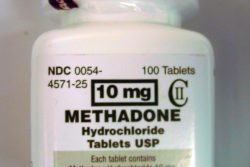How Do You Get Off Methadone?
Methadone is an opioid medication that causes dependency and withdrawals like other opioids making it difficult to stop using without taking the appropriate steps to detox from the drug. For those in an opioid treatment program (OTP), methadone used in medication assisted therapy (MAT) is a recommended alternative to illicit opioid abuse and a planned withdrawal should be undertaken conservatively. According to the University of Texas Medical School at Houston, “Unfortunately, the vast majority of patients tend to relapse to heroin or other opiates during or post-detoxification, which is not wholly surprising given the chronic and relapsing nature of opioid dependence.”

Methadone has high potential for withdrawal and addiction.
For those who are using methadone for pain management, a gradual reduction of the methadone dose under the supervision of your physician may be suitable when cautions and monitoring processes are in place. Understanding your individual risks and benefits of methadone cessation is important and you should not quit using the methadone on your own without discussing your underlying desire to taper off the drug with your physician.
Methadone Detox
Methadone is a long-acting opioid with an elimination half-life ranging from 8-59 hours. Once a detox point is determined, the dosages will gradually be reduced over a set period of time which may vary by dosage and dependency levels, withdrawal severities, and the complexity of the process. The gradual reduction plans have varying durations, usually 5 – 21 days, with the methadone dosage being reduced at intervals averaging 5mg to 10mg per day.
The goals of methadone detox are to safely eliminate the methadone from the body in a safe and controlled manner with the highest degree of comfort to ensure stability, completion, and success. If the person has been abusing methadone or other substances, it should be reiterated, that, according to the SAMHSA, “Ideally, withdrawal should be attempted when it is desired strongly by a stable patient who has a record of abstinence and has adjusted positively on MAT.”
Methadone Withdrawals
A person who uses methadone regularly, builds up methadone on bodily tissues where it is released, unchanged, into the blood throughout that time period. Depending on the person’s tolerance, metabolic rate, health status, variable physiological adaptations, and the amounts of methadone in their system, withdrawals typically begin within 24 hours of the last dose.
Like other opioids, the symptom logy, severity, and durations of methadone withdrawal will be different for every user typically involving intense cravings, runny nose and teary eyes, mood swings, anxiety, insomnia, depression, muscle and joint pains, nausea, cramping, vomiting, and diarrhea. More serious complications can involve respiratory or cardiovascular distress and in those with compromised health, an exacerbation of any co-existing conditions. These conditions can be mitigated with a closely monitored and appropriate methadone adjustment schedule and through the comprehensive care services found in a professional methadone detox center.